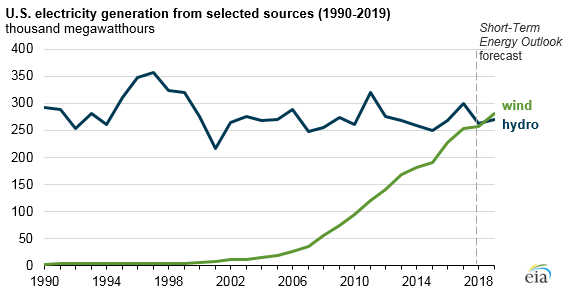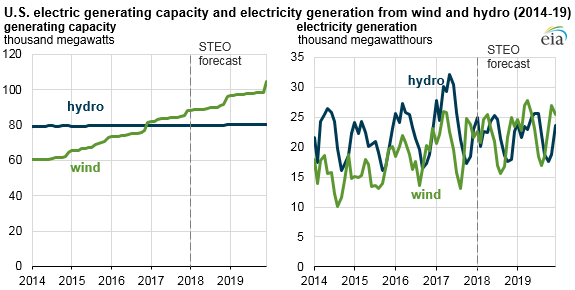This article was published in Scientific American’s former blog network and reflects the views of the author, not necessarily those of Scientific American
Hydroelectric power plants (a.k.a. water and dams) have long been the leading source of renewable electricity in the United States. However, wind power is expected to surpass hydroelectricity by 2019, according to a new forecast published this month by the Energy Information Administration (EIA).

Hydroelectric power was one of the first technologies used to generate electricity in the United States. In 1880, the first industrial use of hydropower to generate electricity was seen in the Wolverine Chair Factory in Grand Rapids, Michigan. Two years later, on 30 September 1882, the first hydroelectric power plant in the United States opened on the Fox River near Appleton, Wisconsin.
On supporting science journalism
If you're enjoying this article, consider supporting our award-winning journalism by subscribing. By purchasing a subscription you are helping to ensure the future of impactful stories about the discoveries and ideas shaping our world today.
Fast forward 135 years to 2017 and hydroelectric power plants were producing around 7.4% of all the electricity generated by utilities in the United States. More than any other renewable resource.
But this is poised to change thanks to rapid growth in wind power as the cost of wind turbines have plummeted.
According to the EIA’s their Short-Term Energy Outlook published this month, the EIA projects that wind will surpass hydro to become the largest source of renewable electricity in the United States.

Source: U.S. Energy Information Administration, Preliminary Monthly Electric Generator Inventory and Short-Term Energy Outlook, January 201
There is, of course, uncertainty around this projection - particularly because electricity generation levels from both hydro and wind are subject to weather conditions. According to EIA analysts:
"Because few new hydro plants are expected to come online in the next two years, hydroelectric generation in 2018 and 2019 will largely depend on precipitation and water runoff…although changes in weather patterns also affect wind generation, the forecast for wind power output is more dependent on the capacity and timing of new wind turbines coming online."
With regards to new wind turbines coming online, the EIA goes on to say that:
" EIA expects significant levels of new wind capacity to come online in 2018 and 2019, similar to the trend in recent years. EIA’s most recent Preliminary Monthly Electric Generator Inventory survey shows wind capacity increasing by 8.3 gigawatts (GW) in 2018 and 8.0 GW in 2019. If these new generating units come online as scheduled, they would add 9% to U.S. utility-scale wind capacity by the end of 2018 and another 8% by the end of 2019.
Because much of the new electric capacity comes online in the final months of each year, these capacity additions affect the subsequent year’s electricity generation values. EIA expects wind to provide 6.4% and 6.9% of total utility-scale electricity generation in the United States in 2018 and 2019, respectively, up from 6.3% in 2017.”